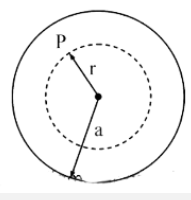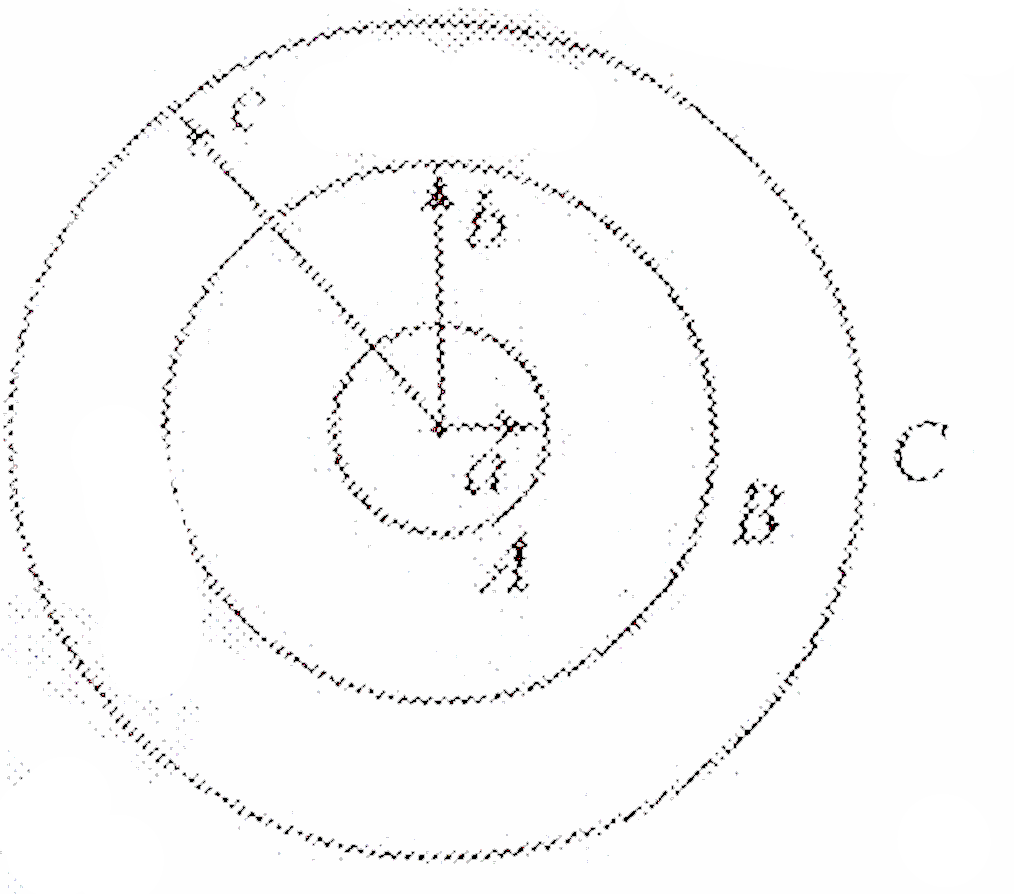A coiaxial cable consists of two thin coaxial cylinders electrically connected at one end, an inner cylindrical conducting tube of radius a carrying a steady current l which is screened by an outer cylindrical conducting sheath of radius b which provides a return path. There is no dielectric medium present.
Use Ampere's theorem to derive the total magnetic energy stored in the space between the conductors, show that the inductance of a length l of the cable is
L=μ0l2πln(ba)
In this cable (a = 5 mm, b = 10 mm, l = 1000 m) is now employed in a (resistanceless) LC circuit containing a capacitance C = 1000 μF, determine the period of oscillations (neglect the capacitance of the cable itself).
To solve the problem, we will follow these steps:
Step 1: Understanding the Configuration
We have a coaxial cable with an inner cylindrical conductor of radius a carrying a steady current I and an outer cylindrical sheath of radius b. We need to find the magnetic field in the region between the two cylinders.
Step 2: Applying Ampere's Law
According to Ampere's Law, the magnetic field B at a distance r from the center (where a<r<b) is given by:
B=μ0I2πr
where μ0 is the permeability of free space.
Step 3: Energy Density Calculation
The energy density u of the magnetic field is given by:
u=B22μ0
Substituting the expression for B:
u=12μ0(μ0I2πr)2=μ0I28π2r2
Step 4: Total Magnetic Energy Calculation
To find the total magnetic energy U stored in the space between the cylinders, we integrate the energy density over the volume of the cylindrical shell:
U=∫udV
The differential volume element dV in cylindrical coordinates is given by:
dV=2πrdrl
where l is the length of the cable. Thus, we have:
U=∫baμ0I28π2r2(2πrdrl)
This simplifies to:
U=μ0I2l4π∫ba1rdr
Step 5: Evaluating the Integral
The integral ∫ba1rdr evaluates to:
∫ba1rdr=ln(ba)
Thus, we have:
U=μ0I2l4πln(ba)
Step 6: Relating Energy to Inductance
The total magnetic energy can also be expressed in terms of inductance L:
U=12LI2
Equating the two expressions for U:
12LI2=μ0I2l4πln(ba)
Cancelling I2 from both sides (assuming I≠0):
L=μ0l2πln(ba)
Step 7: Substituting Values
Given a=5mm=5×10−3m, b=10mm=10×10−3m, and l=1000m:
L=μ0⋅10002πln(10×10−35×10−3)
Using μ0=4π×10−7H/m:
L=(4π×10−7)⋅10002πln(2)=2×10−7⋅1000⋅ln(2)
Calculating ln(2)≈0.693:
L≈1.386×10−4H
Step 8: Finding the Period of Oscillation
In an LC circuit, the period T of oscillation is given by:
T=2π√LC
Given C=1000μF=1000×10−6F:
T=2π√(1.386×10−4)⋅(1000×10−6)
Calculating:
T=2π√1.386×10−7≈2π⋅0.000372≈0.00233s=2.33ms
Final Answers
1. The inductance L of the cable is:
L=μ0l2πln(ba)≈1.386×10−4H
2. The period of oscillation T is:
T≈2.33ms
We have a coaxial cable with an inner cylindrical conductor of radius a carrying a steady current I and an outer cylindrical sheath of radius b. We need to find the magnetic field in the region between the two cylinders.
According to Ampere's Law, the magnetic field B at a distance r from the center (where a<r<b) is given by:
B=μ0I2πr
where μ0 is the permeability of free space.
The energy density u of the magnetic field is given by:
u=B22μ0
Substituting the expression for B:
u=12μ0(μ0I2πr)2=μ0I28π2r2
To find the total magnetic energy U stored in the space between the cylinders, we integrate the energy density over the volume of the cylindrical shell:
U=∫udV
The differential volume element dV in cylindrical coordinates is given by:
dV=2πrdrl
where l is the length of the cable. Thus, we have:
U=∫baμ0I28π2r2(2πrdrl)
This simplifies to:
U=μ0I2l4π∫ba1rdr
The integral ∫ba1rdr evaluates to:
∫ba1rdr=ln(ba)
Thus, we have:
U=μ0I2l4πln(ba)
The total magnetic energy can also be expressed in terms of inductance L:
U=12LI2
Equating the two expressions for U:
12LI2=μ0I2l4πln(ba)
Cancelling I2 from both sides (assuming I≠0):
L=μ0l2πln(ba)
Given a=5mm=5×10−3m, b=10mm=10×10−3m, and l=1000m:
L=μ0⋅10002πln(10×10−35×10−3)
Using μ0=4π×10−7H/m:
L=(4π×10−7)⋅10002πln(2)=2×10−7⋅1000⋅ln(2)
Calculating ln(2)≈0.693:
L≈1.386×10−4H
In an LC circuit, the period T of oscillation is given by:
T=2π√LC
Given C=1000μF=1000×10−6F:
T=2π√(1.386×10−4)⋅(1000×10−6)
Calculating:
T=2π√1.386×10−7≈2π⋅0.000372≈0.00233s=2.33ms
1. The inductance L of the cable is:
L=μ0l2πln(ba)≈1.386×10−4H
2. The period of oscillation T is:
T≈2.33ms
Topper's Solved these Questions
- ELECTROMAGNETIC INDUCTIONBOOK - AAKASH INSTITUTE ENGLISHCHAPTER - ELECTROMAGNETIC INDUCTIONEXERCISE - EXERCISE
30 Videos
- ELECTROMAGNETIC INDUCTIONBOOK - AAKASH INSTITUTE ENGLISHCHAPTER - ELECTROMAGNETIC INDUCTIONEXERCISE - ASSIGNMENT(SECTION - A) (OBJECTIVE TYPE QUESTIONS)
35 Videos
- ELECTROMAGNETIC INDUCTIONBOOK - AAKASH INSTITUTE ENGLISHCHAPTER - ELECTROMAGNETIC INDUCTIONEXERCISE - Assignment (SECTION - I)
6 Videos
- ELECTRIC CHARGES AND FIELDS BOOK - AAKASH INSTITUTE ENGLISHCHAPTER - ELECTRIC CHARGES AND FIELDS EXERCISE - comprehension
3 Videos
- ELECTROMAGNETIC WAVESBOOK - AAKASH INSTITUTE ENGLISHCHAPTER - ELECTROMAGNETIC WAVESEXERCISE - ASSIGNMENT SECTION - D Assertion-Reason Type Questions
25 Videos
Similar Questions
Knowledge Check
A copper cylindrical tube has inner radius a and outer radius b. The resistivity is p. The resistance of . the cylinder between the two ends is
Aρlb2−a2Bρl2π(b−a)Cρlπ(b2−a2)Dπ(b2−a2)ρl
The figure shows the cross-section of a long cylindrical conductor of radius a carrying a uniformly distributed current i. The magnetic field due to current at P is :

View SolutionA long thick conducting cylinder of radius 'R' carries a current uniformly distributed over its cross section :
View SolutionWhen a steady current passes through a cylindrical conductor, is there an electric field inside the conductor?
View SolutionWhen a steady current passes through a cylindrical conductor, is there an electric field inside the conductor?
View SolutionA cylindrical conductor of radius R carrying current i along the axis such that the magnetic field inside the conductor varies as B=B0r2(0<r≤R), then which of the following in incorrect?
View SolutionA long copper tube of inner radius R carriers a current i. The magnetic field B inside the tube is
View SolutionA and C are concentric conducting spherical shells of radius a and c respectively.A is sueeounded by a concentric dielectric medium of inner radius a, outer radius b and dielectric constant k. If sphere A is given a charge Q, the potential at the outer surface of the dielectric is

View Solution
